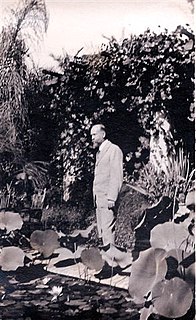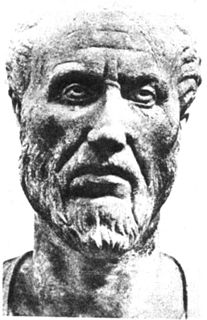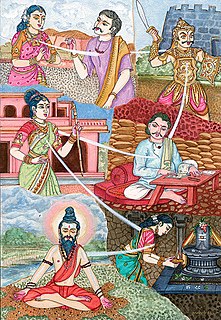 W
WThe 2012 phenomenon was a range of eschatological beliefs that cataclysmic or transformative events would occur on or around 21 December 2012. This date was regarded as the end-date of a 5,126-year-long cycle in the Mesoamerican Long Count calendar, and festivities took place on 21 December 2012 to commemorate the event in the countries that were part of the Maya civilization, with main events at Chichén Itzá in Mexico and Tikal in Guatemala.
 W
WAdonism is a Neopagan religion founded in 1925 by the German esotericist Franz Sättler, who often went by the pseudonym of Dr. Musalam. Although Sättler claimed that it was the continuation of an ancient pagan religion, it has been recognised by academics as being "instead the single-handed creation of a highly gifted and educated man", this figure being Sättler himself. Adonism is a polytheistic religion, revolving around a belief that there are five principal gods: Belus, Biltis, Adonis, Dido and Molchos. Adonis is the most prominent of these in the group's theology, being a benevolent figure that Sättler equated with the Christian figure of Satan. In contrast to Adonis, Molchos is believed by Adonists to be malevolent, and to be responsible for the enslavement of humanity through monotheistic religions such as Judaism, Christianity and Islam: the religion therefore has "a pronounced anti-Christian bias".
 W
WAlchemy is an ancient branch of natural philosophy, a philosophical and protoscientific tradition that was historically practiced in China, India, the Muslim world, and Europe. In its Western form, alchemy is first attested in a number of pseudepigraphical texts written in Greco-Roman Egypt during the first few centuries CE.
 W
WAlfeiós or Alpheios is the main stream of the Alpheios Valley drainage system, a dendritic type, originating on the north slopes of Mount Taygetus, located in the center of the Peloponnesus of Greece, and flowing to the northwest to the vicinity of Olympia, where it turns to the west and, after being impounded by the Flokas Dam, a hydroelectric facility, empties into the Gulf of Kyparissia of the Ionian Sea south of Pyrgos. The entrance into the gulf through agricultural land and across an unpopulated, sandy beach partially blocked by a spit is hydrologically unspectacular, with the water too shallow to be navigable by any but the smallest craft.
 W
WAnno Lucis is a dating system used in Masonic ceremonial or commemorative proceedings, which is equivalent to the Gregorian year plus 4000. It is similar to Anno Mundi.
 W
W"As above, so below" is a popular modern paraphrase of the second verse of the Emerald Tablet, as it appears in its most widely divulged medieval Latin translation: Quod est superius est sicut quod inferius, et quod inferius est sicut quod est superius. That which is above is like to that which is below, and that which is below is like to that which is above.
 W
WAscended masters in the Ascended Master Teachings of a number of movements in the theosophical tradition are spiritually enlightened beings who in past incarnations were ordinary humans, but who have undergone a series of spiritual transformations originally called initiations.
 W
WAccording to spiritual beliefs, an aura or human energy field is a colored emanation said to enclose a human body or any animal or object. In some esoteric positions, the aura is described as a subtle body. Psychics and holistic medicine practitioners often claim to have the ability to see the size, color and type of vibration of an aura.
 W
WThe Bembine Tablet, the Bembine Table of Isis or the Mensa Isiaca is an elaborate tablet of bronze with enamel and silver inlay, most probably of Roman origin but imitating the ancient Egyptian style. It was named in the Renaissance after Cardinal Bembo, a celebrated antiquarian who acquired it after the 1527 sack of Rome. Thereafter it was used by antiquarians to penetrate the meaning of Egyptian hieroglyphs, which were not authentically deciphered until the 19th century. Owing to these prior misconceptions, the tablet became of importance to western esoteric traditions.
 W
WThe Black Sun is a Nazi symbol, a type of sun wheel employed in a post–Nazi Germany context by neo-Nazis and in some strains of Satanism. The symbol's design consists of twelve radial sig runes, similar to the symbols employed by the SS in their logo. It first appeared in Nazi Germany as a design element in a castle at Wewelsburg remodeled and expanded by the head of the SS, Heinrich Himmler, which he intended to be a center for the SS.
 W
WThe Book of Giants is an apocryphal Jewish book which expands the primeval creation to end of time narrative of the Hebrew Bible and, by its multifaceted elaborations on divine decrees of warning and doom, ties the ancient prophet Enoch closer to his generally recognized 'storyline' than does even the story's principal treatise of 1 Enoch. Together with 1 Enoch's Book of Watchers, as Enochian scholar James C. VanderKam maintains, "it stands as an attempt to explain how it was that wickedness had become so widespread and muscular before the flood; in so doing, it also supplies the reason why God was more than justified in sending that flood." The Giants discovery at Qumran dates the text's creation to before the 2nd century BC.
 W
WThe Church of Light was incorporated November 2, 1932 in Los Angeles, California. Its mission is “to teach, practice, and disseminate The Religion of The Stars, a way of life for the Aquarian Age, as set forth in writings of C.C. Zain.” The Church is the continuation of an earlier initiatic organization, the Brotherhood of Light, established in the same city in 1915. The 1932 reorganization as The Church of Light was a response to ordinances passed that year by Los Angeles County “prohibiting both the teaching and practice of astrology.”
 W
WThe Fourth Way enneagram is a figure published in 1949 in In Search of the Miraculous by P.D. Ouspensky, and an integral part of the Fourth Way esoteric system associated with George Gurdjieff. The term "enneagram" derives from two Greek words, ennea (nine) and gramma, and was coined by Gurdjieff in the period before the 1940s.
 W
WThe Garden of Cyrus, or The Quincuncial Lozenge, or Network Plantations of the Ancients, naturally, artificially, mystically considered, is a discourse by Sir Thomas Browne. First published in 1658, along with its diptych companion Urn-Burial, in modern times it has been recognised as Browne's major literary contribution to Hermetic wisdom.
 W
WA grimoire is a textbook of magic, typically including instructions on how to create magical objects like talismans and amulets, how to perform magical spells, charms and divination, and how to summon or invoke supernatural entities such as angels, spirits, deities and demons. In many cases, the books themselves are believed to be imbued with magical powers, although in many cultures, other sacred texts that are not grimoires have been believed to have supernatural properties intrinsically. The only contents found in a grimoire would be information on spells, rituals, the preparation of magical tools, and lists of ingredients and their magical correspondence. In this manner, while all books on magic could be thought of as grimoires, not all magical books should be thought of as grimoires.
 W
WHajj Nematollah was an influential mystic and religious leader of the Qajar Empire. He was born in Jeyhounabad, Iran and is considered one of the greatest leaders and mystics in Kurdish and Ahl-e Haqq history. Two of his most famous works of poetry and history are Furqān al-Akhbar and Ḥaqq al-Ḥaqāyiq yā Shāhnāmah-ʾi Ḥaqīqat. According to Encyclopædia Britannica, "The chief source of information about the Ahl-e Haqq is the Firqan al-Akhbar, written in... early 20th century by …"
 W
WBaron Emmanuel van der Linden d'Hooghvorst (1914–1999), was a Belgian writer, spagyric philosopher and alchemist.
 W
WKrotona was one of three important Theosophical centers in the United States during the early part of the 20th century. Originally built in Hollywood during 1912, the colony was eventually relocated to Ojai, California in 1926, where it operates today as the Krotona Institute of Theosophy.
 W
WThe Likatier tribe is a pseudo-religious community of about 200 people who live and work together in Füssen in the south of Germany. Wolfgang Wankmiller founded the group in 1974. since there had been indecent assaults of children within the "Likatier", the group withdaw from puplic. Wankmiller is said to be father of 15 children from different womean.
 W
WErich Friedrich Wilhelm Ludendorff was a German general, politician and military theorist. He achieved fame during World War I for his central role in the German victories at Liège and Tannenberg in 1914. Following his appointment as First Quartermaster-general of the Imperial Army's Great General Staff in 1916, he became the chief policymaker in a de facto military dictatorship that dominated Germany for the rest of the war. After Germany's defeat, he contributed significantly to the Nazis' rise to power.
 W
WMan: Whence, How and Whither, A Record of Clairvoyant Investigation, published in 1913, is a theosophical book compiled by the second president of the Theosophical Society (TS) - Adyar, Annie Besant, and by a TS member, Charles W. Leadbeater. The book is a study on early times on planetary chains, beginnings of early root races, early civilizations and empires, and past lives of men.
 W
WMandaeism or Mandaeanism, also known as Sabianism, is a monotheistic and Gnostic religion with dualistic cosmology. Its adherents, the Mandaeans, revere Adam, Abel, Seth, Enos, Noah, Shem, Aram, and especially John the Baptist. The Mandaeans have been counted among the Semites and speak a dialect of Eastern Aramaic known as Mandaic. The name 'Mandaean' is said to come from the Aramaic manda meaning "knowledge". Within the Middle East, but outside of their community, the Mandaeans are more commonly known as the Arabic: صُبَّة Ṣubba or Sabians. The term Ṣubba is derived from the Aramaic root related to baptism, the neo-Mandaic is Ṣabi. In the Quran, the "Sabians" are mentioned three times alongside Jews and Christians. Occasionally, Mandaeans are called "Christians of Saint John".
 W
WMillenarianism is the belief by a religious, social, or political group or movement in a coming fundamental transformation of society, after which "all things will be changed". These movements have been especially common among people living under colonialism or other forces that disrupted previous social arrangements.
 W
WThe Monas Hieroglyphica is an esoteric symbol invented and designed by John Dee, the Elizabethan Magus and Court Astrologer of Elizabeth I of England. It is also the title of the 1564 book in which Dee expounds the meaning of his symbol.
 W
WRené-Jean-Marie-Joseph Guénon, also known as Abd al-Wahid Yahya, was a French author, Traditionalist and perennial philosopher who remains an influential figure in the domain of metaphysics having written on topics ranging from "sacred science", to symbolism and initiation.
 W
WMysticism is popularly known as becoming one with God or the Absolute, but may refer to any kind of ecstasy or altered state of consciousness which is given a religious or spiritual meaning. It may also refer to the attainment of insight in ultimate or hidden truths, and to human transformation supported by various practices and experiences.
 W
WThe term Neo-Theosophy is a term, originally derogatory, used by the followers of Blavatsky to denominate the system of Theosophical ideas expounded by Annie Besant and Charles Webster Leadbeater following the death of Madame Blavatsky in 1891. This material differed in major respects from Blavatsky's original presentation, but it is accepted as genuinely Theosophical by many Theosophists around the world.
 W
WNeoplatonism is a strand of Platonic philosophy that emerged in the second century AD against the background of Hellenistic philosophy and religion. The term does not encapsulate a set of ideas as much as it encapsulates a chain of thinkers which began with Ammonius Saccas and his student Plotinus which stretches to the 5th century AD. Even though neoplatonism primarily circumscribes the thinkers who are now labeled neoplatonists and not their ideas, there are some ideas that are common to neoplatonic systems; for example, the monistic idea that all of reality can be derived from a single principle, "the One".
 W
WNew Age is a range of spiritual or religious beliefs and practices which rapidly grew in the Western world during the 1970s. Precise scholarly definitions of the New Age differ in their emphasis, largely as a result of its highly eclectic structure. Although analytically often considered to be religious, those involved in it typically prefer the designation of spiritual or Mind, Body, Spirit and rarely use the term New Age themselves. Many scholars of the subject refer to it as the New Age movement, although others contest this term and suggest that it is better seen as a milieu or zeitgeist.
 W
WThe Occult World is a book originally published in 1881 in London; it was compiled by a member of the Theosophical Society A. P. Sinnett. It was the first theosophical work by the author; according to Goodrick-Clarke, this book "gave sensational publicity to Blavatsky's phenomena" and the letters from the mahatmas, and drew the attention of the London Society for Psychical Research.
 W
WThe Oera Linda Book is a manuscript written in a form of Old Frisian, purporting to cover historical, mythological, and religious themes of remote antiquity, from 2194 BCE to 803 CE. Among academics in Germanic philology, the document is considered to be a hoax or forgery.
 W
WRené-Jean-Marie-Joseph Guénon, also known as Abd al-Wahid Yahya, was a French author, Traditionalist and perennial philosopher who remains an influential figure in the domain of metaphysics having written on topics ranging from "sacred science", to symbolism and initiation.
 W
WReincarnation, also known as rebirth or transmigration, is the philosophical or religious concept that the non-physical essence of a living being begins a new life in a different physical form or body after biological death. Resurrection is a similar process hypothesized by some religions, in which a soul comes back to life in the same body. In most beliefs involving reincarnation, the soul is seen as immortal and the only thing that becomes perishable is the body. Upon death, the soul becomes transmigrated into a new infant to live again. The term transmigration means passing of soul from one body to another after-death.
 W
WThe Rosicrucian Cosmo-Conception or Mystic Christianity is a Rosicrucian text by Max Heindel, first published in 1909.
 W
WSpiritism is an 1885 book by German philosopher Eduard von Hartmann, the author of the famous treatise Philosophy of the Unconscious. In professor Corinna Treitel's opinion, publication of this book became one of the "key events" in history of the "German occult movement." This book was "one of the first works to attempt a complete psychological explanation of all occult phenomena." According to Charles Massey, one of the founders of the Society for Psychical Research, publication of this book made the "most brutal blow" out of all ones that were ever directed against Spiritualism.
 W
WSynchromysticism, a portmanteau of synchronicity and mysticism, is "the art of realising meaningful coincidences in the seemingly mundane with mystical or esoteric significance". The word was coined by Jake Kotze in August 2006. Synchromysticism has been described as a phenomenon "existing on the fringe of areas already considered fringe". Steven Sutcliff and Carole Cusack describe synchromysticism as "part artistic practice, part spiritual or metaphysical system, part conspiracy culture", while Jason Horsley describes it as "a form of postmodern animism" that "combines Jung's notion of meaningful coincidences with the quest for the divine, or self-actualization through experience of the divine."
 W
WRené-Jean-Marie-Joseph Guénon, also known as Abd al-Wahid Yahya, was a French author, Traditionalist and perennial philosopher who remains an influential figure in the domain of metaphysics having written on topics ranging from "sacred science", to symbolism and initiation.
 W
WThe third eye is a mystical and esoteric concept of a speculative invisible eye, usually depicted as located on the forehead, which provides perception beyond ordinary sight.
 W
WThe Traditionalist School is a group of 20th- and 21st-century thinkers who believe in the existence of a perennial wisdom or perennial philosophy, primordial and universal truths which form the source for, and are shared by, all the major world religions.
 W
WUniversal Medicine (UniMed) (UM) is "a socially harmful cult" founded and led by Serge Benhayon, a former bankrupt tennis coach from New South Wales (NSW) Australia who has no medical qualifications. It sells "Esoteric healing" products, music, publications, workshops and courses. None of the healing modalities are evidence based or have been proven effective by scientific research. Uruguayan-born Benhayon founded the group in 1999 after receiving what he described as an "energetic impress" whilst on the toilet. A NSW Supreme Court jury found it was true to say that he leads a "socially dangerous" and "socially harmful cult", "intentionally indecently touched" clients and "is a charlatan who makes fraudulent medical claims". In a British court ruling, UM was found to be "a cult with some potentially harmful and sinister elements".
 W
WThe veil of Isis is a metaphor and allegorical artistic motif in which nature is personified as the goddess Isis covered by a veil or mantle, representing the inaccessibility of nature's secrets. It is often combined with a related motif, in which nature is portrayed as a goddess with multiple breasts who represents Isis, Artemis, or a combination of both.
 W
WWatkins Books is London's oldest esoteric bookshop specializing in esotericism, mysticism, occultism, oriental religion and contemporary spirituality. The book store was established by John M. Watkins, a friend of Madame Blavatsky, in 1897 at 26 Charing Cross. John Watkins had already been selling books via a catalogue which he began publishing in March 1893. The first biography of Aleister Crowley recounts a story of Crowley making all of the books in Watkins magically disappear and reappear.
 W
WWestern esotericism, also known as esotericism, esoterism, and sometimes the Western mystery tradition, is a term scholars use to categorise a wide range of loosely related ideas and movements that developed within Western society. These ideas and currents are united by the fact that they are largely distinct both from orthodox Judeo-Christian religion and Enlightenment rationalism. Esotericism has pervaded various forms of Western philosophy, religion, pseudoscience, art, literature, and music—and continues to influence intellectual ideas and popular culture.
 W
WWhite magic has traditionally referred to the use of supernatural powers or magic for selfless purposes. Practitioners of white magic have been given titles such as wise men or women, healers, white witches or wizards. Many of these people claimed to have the ability to do such things because of knowledge or power that was passed on to them through hereditary lines, or by some event later in their lives. White magic was practiced through healing, blessing, charms, incantations, prayers, and songs. With respect to the philosophy of left-hand path and right-hand path, white magic is the benevolent counterpart of malicious black magic.